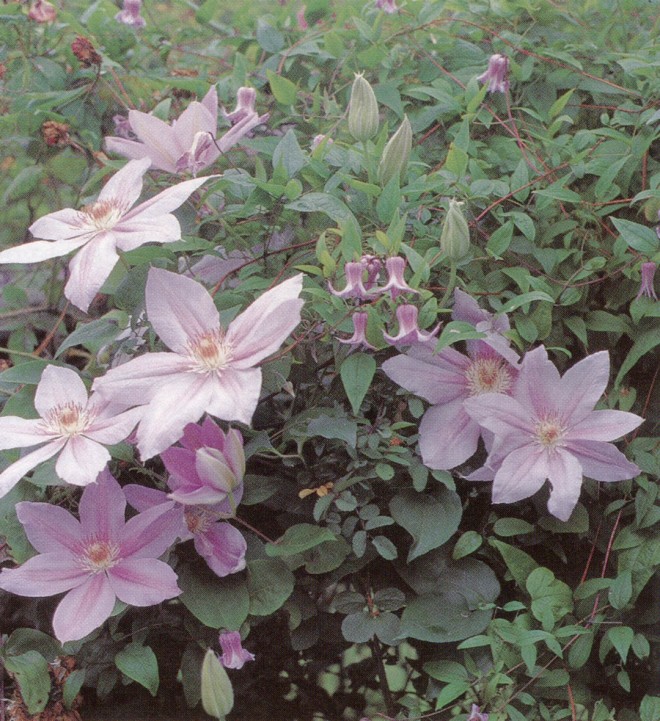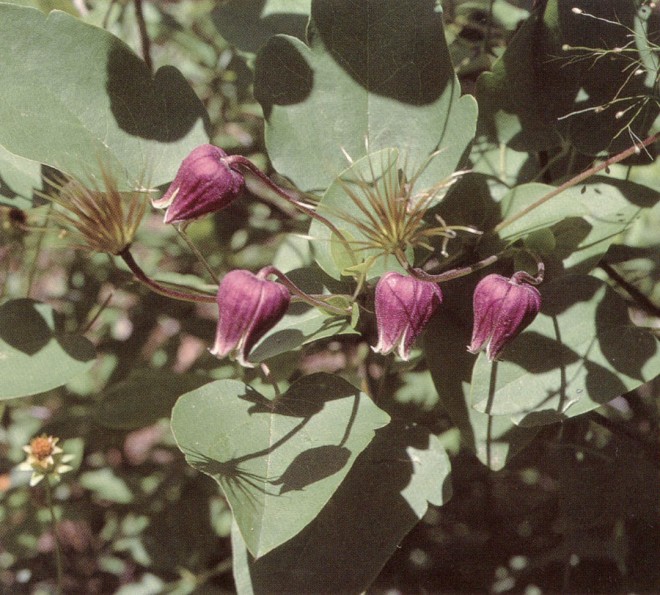
Clematis Go Native in the Pacific Northwest

Contributor
- Topics: Plants You Need, Sustainable Gardening

Clematis belong to the family Ranunculaceae which includes such plants as buttercups, anemones, paeonies, aconites, kingcups, hellebores, etc. Upon inspection it will be found that clematis have no petals, the flower consisting of the sepals which open out with green backs, quickly changing in colour to give us the attractive flower with a central boss of coloured stamens.
Jim Fisk, Clematis, the Queen of Climbers
Although there are many garden-worthy North American native clematis, most of them live in relative anonymity. Precious few are available in commerce, even though some, such as Clematis texensis, are legendary. Seed exchanges often prove frustrating, because clematis seed should be planted when fresh. While they may be difficult to acquire (unless, like me, you love the thrill of the chase), our native clematis are easy to grow in Pacific Northwest gardens. Some are herbaceous perennials rather than vines, making them ideal for the small garden or for container culture.
Clematis columbiana came to me via seed collected from the Columbia River Gorge by Diana Reeck of Collector’s Nursery. Initially, the flowers were smaller and paler than expected. This species bears a strong resemblance to other species in subsection Atragenes, such as C. alpina. After five years in the ground, the windsock-shaped bells are two inches long, and are an intense lavender. The blossoms are produced from mid-March through mid-April. Its host in my garden is a red-flowered Rosa moyesii. The color scheme in this part of the garden shifts completely as the clematis goes out of flower and the rose starts. The mood swings from cool to hot, with no overlap. The rose is ten feet tall and as wide. The clematis has strewn itself throughout the rose. I am always mindful to keep C. columbiana intact when occasionally pruning the rose.

Better represented than the Atragenes clematis in North America is the subsection Viornae with urn-shaped flowers and slender vines. My favorite of these for sheer versatility in the garden is Clematis crispa. I have a lavender-blue form of it, although local gardening friends have seedlings that produce soft purple bells. Among the cognoscenti, C. crispa ‘Rosea’ has become the Holy Grail. No matter what the hue, this species has two defining characteristics: the crimped and crenellated sepals, and the delicate white star in the face of each pendant blossom (a white groove in the center of each of the four sepals produces this cheerful effect). The sepals are ridged and recurved, their edges flounced like a square-dancer’s petticoat—small wonder that in their native Southeast, the common name is curly clematis. This is an indiscriminate breeder, which probably accounts for the color variations. The entire flower, with all its detailing, is about one and a half inches long and chubby in profile. This lightweight vine is pruned in late winter to one foot tall. In my garden it is placed with the early-flowering, fragrant Viburnum carlesii ‘Compacta’, the hybrid perpetual rose ‘Reine des Violettes’, an Oregon native wood rose (Rosa gymnocarpa), and a large-flowered Clematis ‘Peveril Pearl’. Curly clematis winds around and through them all, and begins flowering in late June, poking its bells above the viburnum’s leaves, the rose’s blossoms, and the salad-plate-sized ‘Peveril Pearl’. More blossoms and exploding-cigar-shaped seed heads follow randomly through the summer.

The distinctive flowers of Clematis pitcheri are impossible to mistake once you have made their acquaintance. Though about the same size as C. crispa, they are less fluffy, and are of a striking royal-purple color in the best forms. These urns lack the starry face of C. crispa, so the effect is dark and dramatic throughout. For those who are drawn to dark, vivid colors, this plant is a magnet. This is another dainty vine, easy to place where it can wander on its own. Some plants will make their own serendipitous color combinations in the garden; low-growing shoots sweeping over the rich purple Geranium phaeum ‘Lily Lovell’ in my garden invite a pause for admiration.
Clematis pitcheri prefers well-drained soils as it might have in its native Midwest, and tolerates partial shade in gardens here. In contrast, C. crispa, sometimes found at bog margins in the wild (hence its other common name, marsh clematis), can tolerate wet feet.
Good forms of Clematis viorna are hard to find, and are often misidentified. Native from Pennsylvania south to Georgia, this is also a promiscuous vine, and seedlings can be bland hybrids if other closely allied species are at hand. Ernie and Marietta O’Byrne, in Eugene, Oregon, have a perfect form. The blossoms are over an inch long, slightly ridged and shiny, of a dark brownish-burgundy color, like a highly polished chestnut, with a butter-cream yellow interior and margin on the sepals. The pendulous urns are generously produced on new growth in July, August, and even into September. My C. viorna is paired with Tsuga canadensis ‘Summer Snow’, a dwarf hemlock (slowly reaching fifteen feet); the white new growth on the hemlock provides a good contrast for the dangling flowers. I cut this clematis back to two feet in late winter, although it often dies completely to the ground. It vigorously emerges from its roots in late spring, and leaving a bit of dead stem gives the new spring growth an idea of where I want it to go. (Clematis are eager to please if given proper direction.)

Another delicate vine for weaving through a small shrub is Clematis versicolor, native to the southern states and also allied with C. viorna. The smooth, pendant urn-shaped blossoms are most intensely colored at their juncture with the flower stems, where they are bright or dark pink. The color grades to light pink, and finally creamy-white at the sepal tips, with light interiors. The early flowers are produced in June, and once seed has been harvested, this short vine can be cut back to the first strong bud above the ground. New growth emerges quickly, and the plant is on its way again, flowering again in late September. To give C. versicolor the sharp drainage it requires, I grow it in a large pot with a mix of two parts of potting soil and one part of heavy grit. The pot is refreshed in spring when I remove the top three inches of old soil and replace it with new soil mixed with grit and a scant handful of bone meal. This species does well in the ground for Dorothy and David Rodal on Sauvie Island, northwest of Portland, where it meanders through a deciduous euonymous whose seedhead bears a curious resemblance to the blossom of the clematis.
North American native clematis are only available from specialty nurseries, usually as seedlings in small pots. After several heartbreaks, I have learned that it is safer to plant clematis youngsters into larger pots for at least a year. A well-formed root mass insures robust performance in the mixed border, and keeps unusual clematis from getting lost in the hurly-burly of the garden. This was the case when, after much searching, I obtained Clematis addisonii. It thrives in a capacious pot with gritty soil, and flowers twice per growing season. During and after the initial flowering, the foliage is beset with powdery mildew, due, I am sure, to the fact that spring in Oregon is likely to be more damp than in its native Virginia. I cut the fifteen-inch stems back hard after the first flush of bloom and after the seeds are harvested. New growth—bright and healthy green—emerges during the dry, hot summer. The tiny (three-quarter inch) bells are a smooth bright burgundy-red (the British call it purple), with cream-colored sepal edges and interiors. In a container, I can see the flowers close up, but they would be slightly larger if the plant was in the ground. C. addisonii gets my award for having the most unabashedly adorable clematis blossom.

Receiving similar pot culture in my garden is Clematis ochroleuca, found in the eastern states. Although a chunkier, sturdier plant than C. addisonii in most respects, the flowers are small (three-quarters of an inch) and tubular. They are a subtle greenish-yellow, downy textured, occasionally with a slight purple flush where the sepals join the flower stem. The inner lining of the sepals is lime-green. This clematis would hold its own in the ground but for two factors: the small flowers might not be appreciated as fully, and the foliage, mildewing immediately after flowering, would be unsightly. I grow C. ochroleuca in a pot with free-draining soil. Once the seeds are removed, I cut the plant back to the soil line; it is not unusual for the second flush of growth to have already sprouted. In the fall the plant is more prolific in flower, and it blooms at a shorter height (twelve inches rather than eighteen). If it is planted in the ground, this species will want partial sun, with dappled shade ideal. It is an herbaceous perennial, as is C. addisonii. In the interior valleys of Oregon, Washington, and California with dry heat in the summer, mildewed foliage would rarely be a problem.
Powdery mildew also appears on Clematis texensis and its cultivars. Good forms of the species, which is native to limestone areas of central Texas, are diabolically elusive, but Brewster Rogerson of Hillsboro, Oregon, has an embarrassment of them with vivid Chinese-red urns of varying length. Flowers of the best native forms are red inside and out. C. texensis ‘Duchess of Albany’ is not as badly affected by mildew as some. I have treated my plant with rather a little disrespect by having it share a telephone pole with the English rose ‘Constance Spry’. Both plants enjoy excellent air circulation and full sun, but in this forgettable spot they sometimes are missed at watering time. Nonetheless, they scramble up the pole with mad abandon. ‘Duchess of Albany’ is by far the easiest cultivar to find in the trade, and I do not worry about replacing it, should it meet with foul play growing as it does so near the sidewalk. June is the peak time for this duo, although the clematis continues on and off all summer, after the once-blooming rose has finished.
[sidebar]
Clematis Resource Guide
Nursery Sources:
Collector’s Nursery
16804 NE 102nd Avenue
Battleground, WA 98604
360/574-3832 (mail order)
Exuberant Gardens
22711 Gillihan Road
Portland, OR 97231
503/621-1164
Heronswood Nursery
7530 NE 288th Street
Kingston, WA 98346
360/297-4172 (mail order)
Joy Creek Nursery
20300 NW Watson Road
Scappoose, OR 97056
503/543-7474 (mail order)
Siskiyou Rare Plant Nursery
2825 Cummings Road
Medford, OR 97501
541/772-6846 (mail order)
Northwest Garden Nursery
86813 Central Road
Eugene, OR 97402
541/935-3915
[/sidebar]
Clematis texensis ‘Gravetye Beauty’ came to me from a nursery on the East Coast. The miserable thing arrived, smaller than I had been led to expect and bone dry. After a year of tender care in a larger pot, I planted it in full sun with lots of grit and bone meal in the hole; it rambled through Deutzia gracilis that year, with no blossoms. The next spring I gave it a heavy wire support, and it rewarded my patience with a mass of true red, open tulip-shaped flowers in August, a display well worth the wait. Immediately after flowering, the lowest leaves became mildewy, but at least this annoying development waited until the sepals had dropped. With days shortening, night temperatures falling, and autumn rains starting, there is insufficient time to cut back this vine and expect it to replace its growth before the end of the growing season. It is better to wait until the plant is dormant to do the pruning, right before the next growing season; in Portland (Sunset zone 6, USDA zone 8) that would be late February.
There are many more fascinating American clematis to try (although one or two are rampant thugs), if you can find a source for plants or seeds. Any clematis—including our natives—must be thoughtfully placed in the garden, no matter what the garden’s style. Consideration must be given to flower color and shape, flowering season, vine weight, and mature height. Small flowers, such as those on our native clematis, should be set where they can be enjoyed intimately. Small shrubs near walkways are excellent for this purpose, resulting in perfect plant partnerships. I suspect many clematis collectors share my belief that all trees and shrubs were created to support and display clematis.
Share:
Social Media
Garden Futurist Podcast
Most Popular
Videos
Topics
Related Posts

Low Maintenance Gardens – Better for Pollinators and People
Autumn 2022 “I come out every day. It’s therapy, my meditation.” Janet’s young garden transformed from overgrown, invasive plants to mostly natives. The dailiness of

Calochortophilia: A Californian’s Love Affair with a Genus
Summer 2022 I can chart the progression of my life by Calochortus. For the last two decades, at least. As a teenage girl growing up

Pacific Plant People: Carol Bornstein
Spring 2022 Public gardens play a key role in demonstrating naturalistic planting design, selecting native and adapted plants for habitat, and testing techniques for reducing

Add Year-Round Interest and Winter Blooms for Pollinators
Spring 2022 This article was created from an Interview by Merrill Jensen with Neil Bell in the Summer of 2021 for our Pacific Plant People











Responses